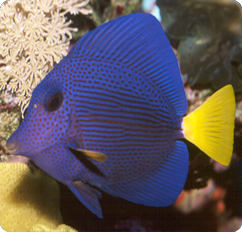|
Zebrasoma xanthurum - Purple Tang
One of the Best Tangs of All  The purple tang (Zebrasoma xanthurum) is one of the more desirable tangs from the genus Zebrasoma despite its reputation for being somewhat aggressive. It’s really hard to beat this fish in terms of beauty, and, because it rarely exceeds 25 cm (about ten inches) in the aquarium, it does well in a tank as small as 100 gallons. Best of all, with the proper husbandry, this is a fairly hardy tang that will adjust readily to aquarium life. The purple tang (Zebrasoma xanthurum) is one of the more desirable tangs from the genus Zebrasoma despite its reputation for being somewhat aggressive. It’s really hard to beat this fish in terms of beauty, and, because it rarely exceeds 25 cm (about ten inches) in the aquarium, it does well in a tank as small as 100 gallons. Best of all, with the proper husbandry, this is a fairly hardy tang that will adjust readily to aquarium life.
Purple Tang Natural History
Commonly known as the dusky sailfin tang, the Red Sea sailfin, the yellowtail surgeonfish, and several other variations thereon, the purple tang is indigenous to the Western Indian Ocean, Red Sea and Persian Gulf. Commonly seen in 20 meters (about 60 feet) of water or less, the purple tang is frequently found in groups on the reef in areas where there is plenty of coral and rock structure. Like most members of the genus, they feed nearly continuously on both micro- and macroalgae. Large adults may reach 22 cm in the wild, but most are half that size.
Purple Tangs in the Saltwater Aquarium
“Personally the purple tang is my favorite Zebrasoma tang because of its beauty and overall hardiness,” says Mark Martin, director of marine ornamental research at Blue Zoo Aquatics. “While they are the most aggressive of the genus, they can be kept in shoals in very large aquaria, which makes for a stunning display.” In general, most aquarist will want to consider keeping this fish singly (and as the only acanthurid, especially Zebrasoma species) in a well-established, under-stocked tank of at least 100 gallons. Make sure the flow is high and the filtration robust. By introducing the purple tang last, much of the potential aggression can be kept to a minimum. While this species in generally considered reef-compatible, it should be noted that individuals may pick at various corals, especially those with large polyps (e.g., Trachyphyllia spp.).
Purple Tang Captive Diet
If the aquarist were to examine the purple tang’s dentition, he or she would see that the many small pharyngeal teeth are perfectly designed for a diet of filamentous algae. As such, this fish is an excellent choice for biological control of algae in the aquarium, especially as the fish matures. In the aquarium, the juvenile purple tang should be offered an omnivorous diet including mysis shrimp and other foods specially formulated for omnivores. Make sure to also offer this fish marine algae (e.g., Nori, SeaVeggies Seaweed, SeaVeggies Flakes, Sun-Dried Seaweed, etc.), and Spirulina flakes. Most purple tangs will readily adapt to a captive diet and will accept most commercially prepared foods including flakes and pellets. Periodically offering an “algae rock” with a mature growth of macroalgae is a welcome addition to this fish’s diet.
Avoiding Diseases, Infestations and Infections
“We recommend soaking the purple tang’s food in a vitamin supplement like Selcon,” says Martin. “This, along with a balanced diet, will help keep the fish healthy.” Tangs have a reputation being susceptible to parasites like Cryptocaryon Irritans and Amyloodinium occelatum. While less prone to the common protozoan infections than many other tangs, the purple tang is more susceptible to head and lateral line erosion (HLLE). “Using a vitamin supplement along with proper husbandry will eliminate the vast majority of illnesses,” says Martin. We recommend using any of the highly unsaturated fatty acid (HUFA) supplements like American Marine’s Selcon, H2O LIFE’s GVH Fish Food Soak and Seaweed Soak, and Kent Marine’s Zoecon. The garlic supplements, such as Kent Marine’s Garlic Extreme and Seachem’s Garlic Guard are also excellent for tangs.
In the event that a purple tang does present with a parasitic infestation, we recommend the use of hyposalinity treatment instead of copper treatment. “Out of all the tangs we deal with,” points out Martin, “purple tangs seem to suffer from HLLE the fastest after exposure to copper, so treat parasites with a hyposalinity treatment instead.” Of course the purple tang, like most fish, should be quarantined prior to adding it to the main aquarium. Freshwater dips may be used during quarantine.
One of the Best Tangs Available to the Saltwater Aquarist
Tangs are beautiful fish, but many get too big or are too difficult to keep. The purple tang is certainly one of the most beautiful tangs, and with the proper husbandry, it will prove a hardy, long-lived fish.
|